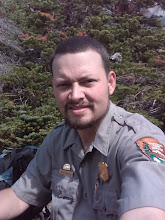I've been really busy at work here lately. The Fourth of July marks the beginning of the busy season here at Glacier National Park. We now have all four loops open in the campground and today we have so many reservations coming in that we don't have any spots for walk-ins. We actually started the day calling in "full," which makes for an easy day.
For the past couple of weeks it's been getting steadily warmer with highs in the upper 70's, but yesterday a cold front moved in bringing rain and highs in the 50's and 60's. Of course this happened on my off days! I don't mind the temps but I am completely over the rain. If it keeps raining on my off days I won't get much hiking in this season.
The day before Chrissy and Lauren left was the first day that the Going To The Sun Road (GTTSR) opened completely, so we decided to drive it. The GTTSR was dedicated in 1933. It is approximately 50 miles long and climbs to an elevation of 6,646 ft as it climbs over the Continental Divide at Logan Pass.

People either love the GTTSR or they hate it. It has been called a "don't look down" kind of drive. Just use the turnouts when you do and you should be fine. In the photo below, you can see the road cut across the mountain in the upper right. Because of the sharp curves and narrowness of the road, vehicles longer than 21 feet are prohibited from traveling on the high-country sections.

This is the only road that completely bisects the park from one side to the other. It connects the eastern plains of Montana with the westernmost reach of the Pacific Northwest rain forest in West Glacier. Traveling the road takes you by glacial carved lakes, through prairies, aspen parklands, spruce-fir forests, old-growth forests of western red cedar, alpine meadows covered in wildflowers, by avalanche chutes, waterfalls and gorges carved by melt water and in view of one of the biggest glaciers still left in the park.

The road is currently going through a ten year rehabilitation. Construction on the road has a couple of sections reduced to one lane which means you have to stop and wait for a pilot car.
Here we are at one of those construction stops.

The wait time is usually only for about fifteen minutes and it gives you a chance to get out of your vehicle, look around and snap some photos. You can see the line of cars waiting behind the girls.

Lauren was definitely glad for a chance to get out of that Jeep!

Taken from the park website:
The road officially received its name, “The Going-to-the-Sun Road,” during the 1933 dedication.The road borrowed its name from nearby Going-to-the-Sun Mountain. Local legend and a 1933 press release issued by the Department of the Interior, told the story of the deity, Sour Spirit, who came down from the sun to teach Blackfeet braves the rudiments of the hunt. On his way back to the sun, Sour Spirit had his image reproduced on the top of the mountain for inspiration to the Blackfeet. An alternate story suggests a white explorer in the 1880s concocted the name and the legend. No matter which version is accurate, the road named Going-to-the-Sun still inspires all who travel it.
Don't roll over!
 This road is one of the toughest roads to snowplow in North America. Up to 80 feet of snow can lie at the top of the road and plowing it can take up to ten weeks.
This road is one of the toughest roads to snowplow in North America. Up to 80 feet of snow can lie at the top of the road and plowing it can take up to ten weeks.This is a view of Logan Pass from the west side of the road.

That's probably enough for now. Next time I will post pictures of what we saw when we reached the top of the road at Logan Pass.

No comments:
Post a Comment
I don't know how many people actually read this, so leave a comment and let me know what you think.